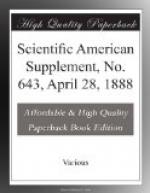The drawing intended for reproduction is pinned on a board and placed squarely before a copying camera in a good, even light. The lens used for this purpose must be capable of giving a perfectly sharp picture right up to the edges, and must be of the class called rectilinear, i.e., giving straight lines. The picture is then accurately focused and brought to the required size. A plate is prepared in the dark room by the collodion process, which is then exposed in the camera for the proper time and developed in the ordinary way. After development, the plate is fixed and strongly intensified, in order to render the white portions of the drawings as opaque as possible. On looking through a properly treated negative of this kind, it will be seen that the parts representing the lines and black portions of the drawing are clear glass, and the whites representing the paper a dense black.
The negative, after drying, is ready for the next operation, i.e., printing upon zinc. This is done in several ways. One method will, however, be sufficient for the purpose here. I obtain a piece of the bichromatized gelatine paper previously mentioned, and place it on the face of the negative in a printing frame. This is exposed to sunlight (if there is any) or daylight for a period varying from five to thirty minutes, according to the strength of the light. This exposed piece of paper is then covered all over with a thin coating of printing ink, and wetted in a bath of cold water. In a few minutes the ink leaves the white or protected parts of the paper, remaining only on the lines where the light has passed through the negative and affected the gelatine. We now have a transcript of the drawing in printing ink, on a paper which, as soon as dry, is ready for laying down on a piece of perfectly clean zinc, and passing through a press. The effect and purpose of passing this cleaned sheet of zinc through the press in contact with the picture on the gelatine paper is this: Owing to the stronger attraction of the greasy ink for the clean metal than for the gelatine, it leaves its original support, and attaches itself strongly to the zinc, giving a beautifully sharp and clean impression of our original drawing in greasy ink on the surface of the zinc. The zinc plate is next damped and carefully rolled up with a roller charged with more printing ink, and the image is thus made strong enough to resist the first etching. This etching is done in a shallow bath, which is so arranged that it can be rocked to and fro. For the first etching, very weak solution of nitric acid and water is used. The plate is placed with this acid solution in the bath, and steadily rocked for five or ten minutes. The plate is then taken out, washed, and again inked; then it is dusted over with powdered resin, which sticks to the ink on the plate. After this the plate is heated until the ink and resin on the lines melt together and form a strong acid-resisting varnish over all the work.




